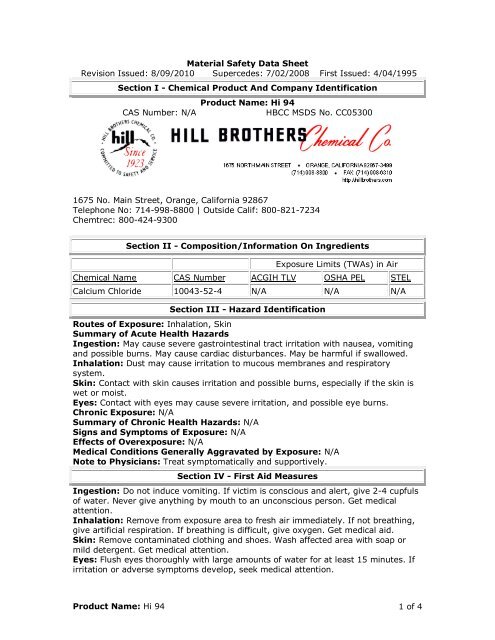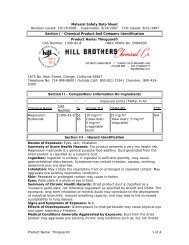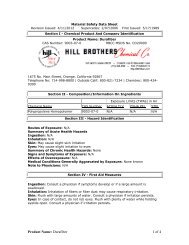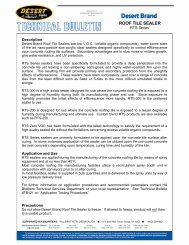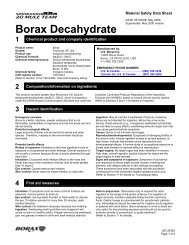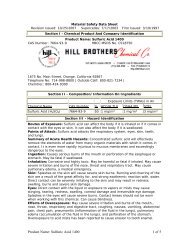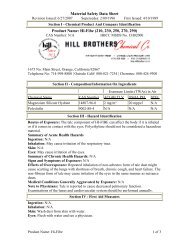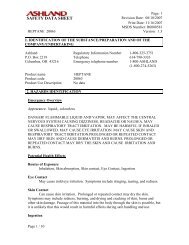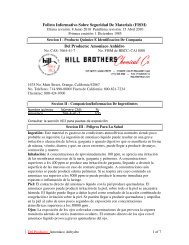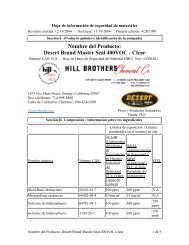Hi 94 - Hill Brothers Chemical Co.
Hi 94 - Hill Brothers Chemical Co.
Hi 94 - Hill Brothers Chemical Co.
Create successful ePaper yourself
Turn your PDF publications into a flip-book with our unique Google optimized e-Paper software.
Material Safety Data Sheet<br />
Revision Issued: 8/09/2010 Supercedes: 7/02/2008 First Issued: 4/04/1995<br />
Section I - <strong>Chemical</strong> Product And <strong>Co</strong>mpany Identification<br />
Product Name: <strong>Hi</strong> <strong>94</strong><br />
CAS Number: N/A<br />
HBCC MSDS No. CC05300<br />
1675 No. Main Street, Orange, California 92867<br />
Telephone No: 714-998-8800 | Outside Calif: 800-821-7234<br />
Chemtrec: 800-424-9300<br />
Section II - <strong>Co</strong>mposition/Information On Ingredients<br />
Exposure Limits (TWAs) in Air<br />
<strong>Chemical</strong> Name CAS Number ACGIH TLV OSHA PEL STEL<br />
Calcium Chloride 10043-52-4 N/A N/A N/A<br />
Section III - Hazard Identification<br />
Routes of Exposure: Inhalation, Skin<br />
Summary of Acute Health Hazards<br />
Ingestion: May cause severe gastrointestinal tract irritation with nausea, vomiting<br />
and possible burns. May cause cardiac disturbances. May be harmful if swallowed.<br />
Inhalation: Dust may cause irritation to mucous membranes and respiratory<br />
system.<br />
Skin: <strong>Co</strong>ntact with skin causes irritation and possible burns, especially if the skin is<br />
wet or moist.<br />
Eyes: <strong>Co</strong>ntact with eyes may cause severe irritation, and possible eye burns.<br />
Chronic Exposure: N/A<br />
Summary of Chronic Health Hazards: N/A<br />
Signs and Symptoms of Exposure: N/A<br />
Effects of Overexposure: N/A<br />
Medical <strong>Co</strong>nditions Generally Aggravated by Exposure: N/A<br />
Note to Physicians: Treat symptomatically and supportively.<br />
Section IV - First Aid Measures<br />
Ingestion: Do not induce vomiting. If victim is conscious and alert, give 2-4 cupfuls<br />
of water. Never give anything by mouth to an unconscious person. Get medical<br />
attention.<br />
Inhalation: Remove from exposure area to fresh air immediately. If not breathing,<br />
give artificial respiration. If breathing is difficult, give oxygen. Get medical aid.<br />
Skin: Remove contaminated clothing and shoes. Wash affected area with soap or<br />
mild detergent. Get medical attention.<br />
Eyes: Flush eyes thoroughly with large amounts of water for at least 15 minutes. If<br />
irritation or adverse symptoms develop, seek medical attention.<br />
Product Name: <strong>Hi</strong> <strong>94</strong> 1 of 4
Flash Point: N/A<br />
Lower Explosive Limit: N/A<br />
Section V - Fire Fighting Measures<br />
Autoignition Temperature: N/A<br />
Upper Explosive Limit: N/A<br />
Unusual Fire and Explosion Hazards: Negligible fire hazard when exposed to heat<br />
or flame.<br />
Extinguishing Media: Dry chemical, carbon dioxide, water spray or regular foam.<br />
For larger fires, use water spray, fog or regular foam. (1996 Emergency Response<br />
Guidebook, DOT P 5800.7).<br />
Special Firefighting Procedures: Move container(s) from fire area if you can<br />
without risk. Apply cooling water to sides of containers that are exposed to flames<br />
until well after fire is out. Extinguish fire using agent suitable for type of surrounding<br />
fire and or chemicals. Do not use water directly on material. Avoid breathing<br />
corrosive vapors; keep upwind. Wear full protective clothing and NIOSH-approved<br />
self-contained breathing apparatus with full face-piece operated in the pressure<br />
demand or other positive pressure mode. At high temperatures or when moistened<br />
under fire conditions, calcium chloride may produce toxic or irritating fumes.<br />
Section VI - Accidental Release Measures<br />
Vacuum or sweep up material and place into a suitable disposal container. Clean up<br />
spills immediately. Avoid generating dusty conditions. Wear appropriate protective<br />
gear for the situation. See personal protection information in Section 8.<br />
Section VII - Handling and Storage<br />
Avoid skin and eye contact and breathing dusts. Wash thoroughly after handling.<br />
Launder contaminated clothing before re-use. Observe all federal, state, and local<br />
regulations when storing this product. Store in a covered, clean and dry container<br />
away from incompatible material. Always use cool water when dissolving calcium<br />
chloride. Heat evolved is significant.<br />
Section VIII - Exposure <strong>Co</strong>ntrols/Personal Protection<br />
Respiratory Protection: A respirator is not indicated under normal operating<br />
conditions. Use of a NIOSH approved respirator should be based upon the presence<br />
of nuisance dust. When warranted, use a face mask particulate respirator with a<br />
NIOSH N95 rating such as Moldex 2800N95, MSA 816581 or 3M 8576PN5 or<br />
equivalent.<br />
Ventilation: Provide local exhaust ventilation system.<br />
Protective Clothing: Wear appropriate protective (impervious) clothing. Leather<br />
work boots and/or leather products will dehydrate with resultant shrinkage and<br />
possible destruction.<br />
Eye Protection: Wear safety glasses with splash shields or safety goggles/shield.<br />
Where there is a possibility of exposure, eye wash fountain and safety shower should<br />
be provided within the immediate work area for emergency use.<br />
Other Protective Clothing or Equipment: Wear appropriate non-leather<br />
protective gloves and boots.<br />
Work/Hygienic Practices: Wash hands with soap and water before eating,<br />
drinking, smoking, or using toilet facilities. Do NOT place food, coffee or other drinks<br />
in the area where dusting or splashing of solutions is possible.<br />
Product Name: <strong>Hi</strong> <strong>94</strong> 2 of 4
Section IX - Physical and <strong>Chemical</strong> Properties<br />
Physical State: Solid pH: 9-10<br />
Melting Point/Range: 187°C; 369°F Boiling Point/Range: 2912°F<br />
Appearance/<strong>Co</strong>lor/Odor: White pellet/flakes, odorless.<br />
Solubility in Water: 40% @ 20°C (68°F) with evolution of heat.<br />
Specific Gravity(Water=1): 1.85 Molecular Weight: 111.0 – 150.0<br />
Vapor Density(Air=1): N/A<br />
How to detect this compound : N/A<br />
% Volatiles: N/A<br />
Vapor Pressure(mmHg): N/A<br />
Solvent Solubility: Soluble in alcohol, acetic acid and acetone<br />
Stability:<br />
Stable<br />
Section X - Stability and Reactivity<br />
Hazardous Polymerization: Will not occur under normal<br />
temperatures and pressures<br />
<strong>Co</strong>nditions to Avoid: Anhydrous form reacts exothermically with water. Dust<br />
generation, excess heat, exposure to moist air or water.<br />
Materials to Avoid: Strong oxidizing agents, Bromine trifluoride, 2-<br />
Furanpercarboxylic Acid.<br />
Hazardous Decomposition Products: Hydrogen chloride, calcium oxide<br />
Section XI - Toxicological Information<br />
TDLO: 112 g/kg, oral, 20 weeks, rat<br />
LDLO: 274 mg/kg, subcutaneous, dog<br />
LD50: 1000 mg/kg, oral, rat<br />
LD50: 264 mg/kg, intraperitoneal, rat<br />
Local Effects: Eye, mucous membrane and skin irritant.<br />
Health Effects: Moderately toxic by ingestion, slightly toxic by thermal absorption.<br />
N/A<br />
Section XII - Ecological Information<br />
Section XIII - Disposal <strong>Co</strong>nsiderations<br />
Observe all federal, state and local regulations when disposing of this substance.<br />
DOT Proper Shipping Name: N/A<br />
DOT Hazard Class/ I.D. No.: N/A<br />
Section XIV - Transport Information<br />
Section XV - Regulatory Information<br />
Reportable Quantity: N/A<br />
NFPA Rating: Health - 1; Flammability - 0; Instability - 1<br />
0=Insignificant 1=Slight 2=Moderate 3=<strong>Hi</strong>gh 4=Extreme<br />
Carcinogenicity Lists: No NTP: No IARC Monograph: No OSHA Regulated: No<br />
SARA Title III: Section 311: Acute Hazard, Reactivity Hazard<br />
Product Name: <strong>Hi</strong> <strong>94</strong> 3 of 4
Section XVI - Other Information<br />
Synonyms/<strong>Co</strong>mmon Names: Anhydrous Calcium Chloride, Prilled Calcium<br />
Chloride, Calcium Dichloride<br />
<strong>Chemical</strong> Family/Type: Inorganic Salt<br />
Sections changed since last revision: X<br />
IMPORTANT! Read this MSDS before use or disposal of this product. Pass along the<br />
information to employees and any other persons who could be exposed to the<br />
product to be sure that they are aware of the information before use or other<br />
exposure. This MSDS has been prepared according to the OSHA Hazard<br />
<strong>Co</strong>mmunication Standard [29 CFR 1910.1200]. The MSDS information is based on<br />
sources believed to be reliable. However, since data, safety standards, and<br />
government regulations are subject to change and the conditions of handling and<br />
use, or misuse are beyond our control, <strong>Hi</strong>ll <strong>Brothers</strong> <strong>Chemical</strong> <strong>Co</strong>mpany makes no<br />
warranty, either expressed or implied, with respect to the completeness or<br />
continuing accuracy of the information contained herein and disclaims all liability for<br />
reliance thereon. Also, additional information may be necessary or helpful for specific<br />
conditions and circumstances of use. It is the user's responsibility to determine the<br />
suitability of this product and to evaluate risks prior to use, and then to exercise<br />
appropriate precautions for protection of employees and others.<br />
Product Name: <strong>Hi</strong> <strong>94</strong> 4 of 4


